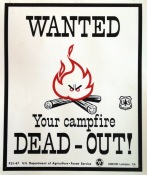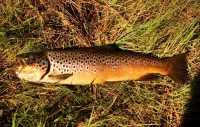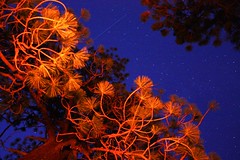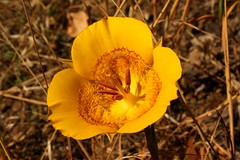I remember sitting in seventh grade math class at La Colina Jr. High one afternoon and itching the hell out of some poison oak on my upper thigh.
I managed to scratch it into a puffy, red blistery mess, and then used my mechanical pencil to pop the tiny serous filled vesicles that had erupted by the hundreds. It was a great distraction.
I walked out of class with a mean looking wet rash that felt hot and hung stiff and heavy on my leg, as if it had been welded to my skin like a vulcanized patch on a bike tire tube.
Such were the wages of the early years. The maddening unbearable-to-resist itch and constant fidgeting, the blisters, the hideous looking dermatitis, and the rashes scratched raw which made showering torturous and sleeping difficult.
Even though I habitually used mugwort as a preventive, inevitably I’d miss a spot, and it would erupt into a rash that I couldn’t resist itching which would then spread. On the flip side, for all the inconvenience and discomfort, itching a good case of poison oak was about the best feeling I knew back then, and almost made it all worth it.
Eating For Immunity
There was a time when I avoided poison oak like an airborne contagion. Nowadays I eat it. And without concern, if need be, I tromp right through the bushiest groves with the biggest, oiliest looking leaves. Rarely do I break out with any sort of dermatitis. At most, if I do have a reaction, it’s short lived and not more than a slight red tinge to my skin in a few select places.
 Every season in winter or early spring when poison oak sprouts new leaves I eat them. I pinch off the smallest ones, place them on my tongue and mince them into a sappy pulp with my front teeth and swallow the mush. I repeat this several different times early in the calendar year.
Every season in winter or early spring when poison oak sprouts new leaves I eat them. I pinch off the smallest ones, place them on my tongue and mince them into a sappy pulp with my front teeth and swallow the mush. I repeat this several different times early in the calendar year.
After constant exposure through the years, and especially ever after I began eating it, my reaction became increasingly milder until it was essentially non-existent. I never once broke out in a rash from eating poison oak or suffered any adverse consequences.
Traditional Knowledge
Historically, California Indians valued poison oak for numerous purposes. Costanoan Indians used poison oak leaves to wrap food in and wove the plant’s tender and flexible stems into baskets. Indians in Mendocino County used poison oak leaves to wrap up acorn mush in preparation for baking and the Karok used the plant’s twigs as skewers for smoking salmon.
The Chumash used poison oak medicinally in an effort to cure a host of ailments. Early California mission documents mention the use of poison oak poultices that were “very effective in healing wounds,” writes Jan Timbrook in Chumash Ethnobotany. The juice or sap that flows from young stems was also used to stop bleeding.
The Franciscan priest at mission San Luis Obispo in the early nineteenth century, to note a rather dramatic example, witnessed powdered poison oak used to heal the severe wounds a man suffered during a bear attack. In his own words:
“The Indians have no physicians but they have healers who administer their remedies to the sick. … The remedies they employ are plants, bark, roots and the leaves of various kinds of trees which I do not know except the ivy from which I have seen them make plasters, for instance in the case of a man who had been frightfully lacerated by a bear in the arms, legs, sides and shoulders. He was cured by simply being covered with the powder of the ivy.”
According to Timbrook, the historic populations of Chumash were largely immune to poison oak’s rash causing poison, while visiting Indians from other regions were often highly allergic. Immunity apparently waned in later generations among whom, presumably, traditional medicinal practices were no longer used and there was less exposure to the plant in the wild.
The Mahuna Indians of California steeped dried poison oak roots in water and drank the resulting decoction as a preventive against future allergic reaction to the plant. To obtain immunity the Tolowa ate the youngest leaves in early spring just as they began to form and sprout.
Eating poison oak to avoid getting it may sound totally nuts, but considering the plant’s traditional Native American uses it shouldn’t sound so crazy after all. Just don’t blame me if you chomp down a leaf and end up in the hospital.
United States Department of Agriculture Database: Profile page for Pacific Poison Oak.
Bibliography
Jan Timbrook, Chumash Ethnobotanty: Plant Knowledge Among the Chumash People of Southern California (Santa Barbara Museum of Natural History 2007), 214-17.
Maynard Geiger and Clement W. Meighan, Eds., As the padres saw them : California Indian life and customs as reported by the Franciscan missionaries, 1813-1815 (Santa Barbara Mission Archive Library 1976), 75.
John Bruno Romero, The Botanical Lore of the California Indians (Vantage Press 1954), 11.
Marc A. Baker, The Ethnobotany of the Yurok, Tolowa and Karok Indians of Northwest California (Humboldt State University, M.A. Thesis 1981), 58.
Barbara R. Bocek, Ethnobotany of Costanoan Indians, California, Based on Collections by John P. Harrington (New York Botanical Garden Press 1984), 251.
V. K. Chestnut, Plants Used by the Indians of Mendocino County, California, Reprint of U.S. National Herbarium Contributions Vol. VII, pp295-422 (Mendocino County Historical Society Inc.; Reprint edition 1974), 364.
Sara M. Schenck and E. W. Gifford, Karok Ethnobotany (University Of California Press Berkeley 1952), 385.



































I remember getting my first exposure to poison oak. I got it exploring the avocado orchards behind my house when I was a kid. I was in junior high too (GVJH). I just could not resist scratching. Running hot water on the rash felt sooo good, but was so bad. It was so bad my eyes swelled shut for a day or two. I’ve never gotten a case as bad as that first one. These days I just scrub down with Tecnu when I get home. If I’m at a campsite a wipe down with a rag soaked in white gas works well too. I never knew about Mugwort.
This was a really well written post. Your description of your rash was graphic and spot on, “…welded to my skin like a vulcanized patch on a bike tire tube” yuck.
I have that rash in my mouth do you think I’m going to die?
that my friend is an STD
Fantastic wordsmithing, Jack.
I will admit I cringed at the very thought of eating poison oak (my initial reaction was something akin to “I might as well go play on the freeway to make myself immune to getting run over by a truck!”), but when I read Timbrook’s book a while back I must further admit the notion had some appeal.
O happy days would be those without fear of that evil weed … .
Thanks guys, I appreciate the kind words.
I have been eating poison oak for about the past 35 years . My father was a dermatologist and he recommended it to me as I was growing up. I haven’t gotten a rash since I started eating it. I started my daughter eating it at the age of 5 , she never gets it either.
Great write-ups. I know a few other guys who spend lots of time in the local backcountry that swear by the “ingestion” method of PO prevention. They claim it works. Seems like a risky endeavor though if you’re really sensitive to it.
Apparently the Mugwort works as well. I too, have read some of Jan Timbrook’s writings on Chumash Ethnobotany, and have shared the “secrets” of mugwort with others. On a similarly-related note, if you ever need to wash your hands, ceanothus blossoms make a great soapy lather with a little water.
Anyway, I’m fortunate; I don’t seem to get the stuff (PO).
I still do what I can to avoid it though. No point in pushing my luck.
Thanks Nico. I read in Timbrook’s book that yucca root makes good soap. I was out hiking the other week thinking about that and what a pain it would be to uproot a yucca to get at the root just for soap. Then I came across a yucca that had been eroded out of a bank and tried it out. If you pound the root it makes a frothy pulpy juice that does in fact work well for soap. It has a high viscosity that sticks to your hands with almost an oily feel, but it washes clean and I was surprised at how soft it left my hands.
I recall the reference to the Yucca root, but like you, figured it was a lot of work to get to a Yucca root just for some soap! The ceanothus blossoms are much easier to harvest! It lathers up just like a bar of soap.
I think I’m going to try this I’ve been really allergic all my life, i am about to start working around this stuff quite frequently so why not try to prevent it. ill post again if i die or something.
Jordan you never did write back, you still with us?
Did you die?
Its been 10 years you guys think hes okay?
There used to use a product called “immune oak“. It used to be available in pharmacies. It was made from a poison oak extract and you would take it in small doses over a period of a month. At the time I was living on a ranch and poison oak was absolutely everywhere. It definitely increased my resistance. I will be curious to read your results.
Keep me posted I think I would give it a shot if you don’t die Jordan. Im just getting over a PO rash. It was mild compared to my cousin, but still a pain. I wish I could train the damb dogs to stay out of that devil weed.
Ingestion isn’t as crazy as it sounds. There is sound medical evidence that ingestion of allergens, (peanuts for example) can lessen the impact of future exposure.
I’m lucky I guess, so far I have never gotten that horrible rash. Some scouts in my troop back in the day however decided those long stems would make great kindling during a campfire. Talk about chemical warfare; the resulting oil-filled plume would be serious trouble to anyone highly sensitive to P.O. Everybody ran for the hills.
Inhaling smoke from burning poison oak brush can cause life threatening inflammation of the lungs
Well I’m terribly allergic to poison oak. My girlfriend who is a great forager walked up to a newly shooting plant grabbed the new leaves and tossed them into her mouth, chewed them up and swallowed. I was dumbstruck but I have come to be very respectful of her knowledge of the outdoors. What the hell, I grabbed some and chewed them up as well, much to the horror of my best friend who is also really sensitive to poison oak. It’s now 4 days later and I don’t have any internal signs of poison oak. Ha! This is amazing. Now to find some more of the stuff and work on building up my immunity. I really hope this works.
Only sad that I will no longer be able to experience showering blistering hot water on my poison oak rashes, the experience is, dare I say, more pleasurable than sex on some levels. Found this out when I was covered 75% by poison oak. Got that coverage a while back, was new to the west coast and didn’t know what poison oak looked like, had sex in a field of poison oak. Oh yeah.
Hey Eric. Thanks for your comment.
You said, “the experience is, dare I say, more pleasurable than sex on some levels.”
Funny you should say that. That is precisely what I had in mind when I wrote the post and I said, “itching a good case of poison oak was about the best feeling I knew back then.”
I was reminded of this experience by the “Eric” post above. I’d always wondered if anyone else had had this happen with hot water. Have mentioned it several times over the years but never had anyone say, “yeah me too!”. So was interesting to find that. Thanks for your post on this subject.
The hot water in the shower healing is pre orgasmic. Though I’m worried it may be counterproductive. When I get out of the shower, though invigorated, wink, I’m more inflamed than ever.
My grandfather writes of getting the dread PO every spring when the winds blew down from the Berkeley hills. That was in the early 1900’s before the hills were built up. From the description of his symptoms (wretched sore throat, fever, cough, weeks of misery), it does sound like he inhaled it in some way. I got PO internally when I was two months pregnant by breathing smoke from a barbecue in Tilden Park and nearly died. Had to take steroids and my baby was born with an eye defect as a result. Curious: is it possible for the winds to spread it without smoke, or is it more likely that people were burning it back then and the winds picked up the smoke? He was a professor at Cal and seriously considered changing his career and moving somewhere else because of his yearly misery. Must have been quite bad.
Wow! What a story. Thanks for sharing. I’m no expert, and I certainly don’t mean to discount what your grandfather said, but I find it hard to believe that a person could get it from the plant blowing in the wind. From your short description, though sounding quite the same as PO, could just as easily be severe allergic reactions to other allergens. I’ve never heard of anybody getting it through the air or wind, though it is well known that PO laden smoke can and does affect people.
Might be true. We lived in the south. My mom was VERY sensitive to poison ivy. She always claimed if she was close enough downwind of it she’d break out in a rash.
I believe it to be true. I live in the foothills. My property is covered in poison oak. In early spring some of the plants have little round pods on them filled with pollen. I assume it is the Male plant. Any way the pollen does get on my outdoor furniture and if I don’t wash them before I sit I will get a rash.
I wanted to report back on eating PO just for the sake of recording experiences on this subject. BTW this is the same Erik with a “k” as above. A little over a week ago I ate (chewed and swallowed) several shoots of PO and I did contract PO rashes. Not externally so much, not internally so much, but on the regions between external and internal. Huh? The lips of my mouth and my anus. Yup I said it. I suppose saliva coming back out of my mouth carried some oil onto my lips. And I assume y’all can figure out how the other was carried. This was pleasant in neither area. My lips swelled, kinda like getting free collagen injections, and were not so much itchy as they were just uncomfortable. Now the extra tissue left by the rash is repeatedly drying and cracking. The other end was like having a really itchy butthole. How’s that for too much information? Sorry, felt it needed to be set down. For posterity?
I will try again I suppose, the upside possibilities seem worth at least one more shot.
Oh no! Sorry to hear that! I guess I was lucky in not getting it in my initial consumption years ago. I’ve eaten it several times earlier this year without any reaction. I can only presume that due to my constant exposure in my earlier years, and despite those years of constant rashes, that somehow I had some level of immunity when I first ate it. That doesn’t really make sense, but I don’t know what else it could have been.
LMBO! from what I’ve read, everything says to start slow. I have not tried this yet but instead of several shoots, just one a day, like described above.
LMBO! from what I’ve read, everything says to start slow. I have not tried this yet but instead of several shoots, just one a day, like described above.
Thank you for the report and the details. Not just about your anus but also the amount you ate. I believe that is important. I think the Indians probably knew just how much to eat. Seems like it has to be quite a small amount.
Ive eaten just one bud before it was fully open for many years now. Sometimes I get an itchy bump in several places like arm, leg or neck, but not internally. I really think it has helped considering how badly I used to get it.
Glad I was turned on to your great blog just the other day but wish I’d discovered it before Erik tried your method. I first learned about mugwort back in the mid-70s from the late Chumash elder Juanita Centeno who was also one of Jan Timbrook’s teachers. Juanita said that growing up she noticed that most of her people didn’t contract the rash but she did. Her aunt made a tea of poison oak root and had her drink it in the winter. Then in the early spring, she ate the youngest leaves as you described doing. She said she never got it again. I shared that with a friend who tried eating some leaves and got a terrible internal rash including mouth, throat, etc. A safer way to do that is to embed the leaf in a piece of supermarket-type bread and squeeze and roll it into a soft pill to swallow, bypassing the mucus linings and letting the stomach acids deal with it. BTW, I’ve been leading Herb Walks around Ojai since back in the day and I’m finally doing one in Santa Barbara on April 15 on the same trail I once walked with Juanita. Please check it out at http://herbwalks.com/ai1ec_event/santa-barbara-herb-walk/?instance_id=75. Thanks for the great research and writing. I’ll be back.
Thank you for your comment and advice!
Doctorkdog that is great advice because once again I’ve got poison oak rashes on my lips, inside of my mouth and in my esophagus… and around my butthole of course. Ha ha! If I don’t laugh I’ll cry.
But! this time the poison oak rashes seem to be weaker and are going away after only a couple days! This is Wednesday and I consumed 10 groups of 3 shoots on Sunday. So I think some success is being witnessed! If one can call it that. Heh. Typically I’d have the rashes for a week or two.
Putting the PO inside of bread (or how about gelatin caps?) sounds like a winning idea!
Now about the butthole, any ancient tricks?? Don’t eat poison oak you say. Heh, yes that sounds like the only way to avoid that furious scratching. I never thought a bottle brush could be so handy. Kidding!!
Questions on the poison oak root tea, did she happen to mention if it was consumed several times during the winter or just once? Any rashes contracted for the tea? Did this process need to be repeated yearly or just once? Do you know how old she was when she first had the tea and leaves?
Cheers!
As i recall, she was about 8 years old at the time. I believe, but I can’t be certain now, that she said she drank it several times, which would make sense. She reported no reaction to the tea. The root would contain some of the plant protein (what would build immunity) but little, if any, of the toxic oil. She only did it for one season and ate only the youngest leaves. In years of teaching people about native plants on my Herb Walks I’ve had only a couple of cases of people having a reaction due to being allergic or hypersensitive to a particular plant. Stinging nettles can be eaten raw and deadly nightshade berries too if you know what you’re doing. On the other hand, the common garden weed malva, harmlessly edible to most people, can cause a severe reaction in some, especially if they juice it or otherwise ingest an excessive amount. The key is to exercise caution when trying a new wild food or medicine, and extreme caution if it’s a known toxin like poison oak. Hey, the name has “poison” in it! So I would recommend, if you’re determined to try this method, that you start with one leaf, wait a couple of days and, if no reaction, then try two and so on. Always wear long sleeves and long pants when hiking around it, stay away from dogs that have possibly been out in it, use the mugwort as Jack describes, don’t handle plants near it, and wash immediately after contact. There are natural saponaceous plants that can be used for that on the trail.
Great info doctorkdog. It would be great to have some guidelines on how to make poison ivy tea on this page, do you have a notion of how it was made? Just dig up a plant, clean the root and pop that in some hot water? Does the root need to be crushed at all? I’m guessing this will taste not so good.
I’d love to see bottles of poison ivy shoot capsules on the shelves of a store. Or boxes of poison ivy root tea bags. Put a hidden video camera next to the packages just to see the reaction on people’s faces.
You’ve got the basic idea but I hesitate to publish a recipe for poison oak root tea as I can’t really advocate it. There are some excellent online references on preparing plants teas and such in the “Links to Resources” page on my website (www.HerbWalks.com/links) including some great little manuals by the late Michael Moore who is the ultimate source of info on medicinal uses of Western American plants. Here’s a link to his “Herbal Materia Medica”: http://www.swsbm.com/ManualsMM/MatMed5.txt. If you scroll down past the alphabetical list of plants there’s a section on basic preparation methods. Roots are usually prepared as a decoction.
Another option is already in some drugstores and natural food stores. It’s the homeopathic remedy Rhus toxicodendron which is prepared from poison ivy. Here’s the story on that: http://www.herbs2000.com/homeopathy/rhus_tox.htm. Have fun!
I’m all for an easy cure to poison oak dermatitis, but the evidence here is less than solid, and the evidence for any kind of homeopathic remedies is zero. (Sorry, there’s no polite way to say this.) The real way to do it would be a placebo controlled large group. The thing is, if you want something to be true (like the eating-poison-oak-to-avoid-poison-oak theory) and you happen to not get poison oak for a long stretch after you start this method, you might (incorrectly) interpret that as meaning it worked. Meanwhile there are people getting intubated in the ER because they tried eating it.
Hey Michael. I know what you’re saying. I’m not looking to prove anything, just reporting what worked for me. There was no wanting or desire on my part for anything to be true. Perhaps I’ve incorrectly attributed my effective immunity to consumption and constant exposure, anything is possible, but there is no other answer in my case unless I for some odd reason just stopped getting it, which makes zero sense. The evidence in my case suggests eating it worked, because my reaction to it following consumption was decidedly less severe. What other answer is there for this fact? Furthermore, it’s a conclusion on my part that happens to coincide with historical reports from Native Americans and the findings of the ethnobotanist cited.
When I was 9 in Santa Barbara, I got poison oak so bad from wandering around the creek I had to get a steroid injection. My dad found a remedy from the Doc which was an extract of poison oak which was mixed in with a little water and drunk once a month for 4 months. Never got it again after. Tasted sassafrassy.
Many years ago, I used to use a product called “immune oak” or something close to that. It was made in La Jolla, California. It was a pure extract of poison oak. You would take a small vial, then another the next day. It would last one month before you had to take another dose. It worked well. I was living on a ranch where there was more PO than there was dirt. I never got it.
So I’m supposed to blithely take the advice of a blogger who doesn’t know the difference between “scratch” and “itch?”
That’s your assumption, which is incorrect.
The two words, in common practice, are used interchangeably, a fact you may note if you consult a dictionary.
Random House 2013:
itch
[ich]
verb (used without object)
1.
to have or feel a peculiar tingling or uneasy irritation of the skin that causes a desire to scratch the part affected: My nose itches.
2.
to cause such a feeling: This shirt itches.
3.
Informal. to scratch a part that itches.
Collins English Dictionary Unabridged 10th Edition:
itch
— n
1. an irritation or tickling sensation of the skin causing a desire to scratch
2. a restless desire
3. any skin disorder, such as scabies, characterized by intense itching
— vb
4. ( intr ) to feel or produce an irritating or tickling sensation
5. ( intr ) to have a restless desire (to do something)
6. not standard to scratch (the skin)
Great info. I do respect ancient knowledge. We live in a society that only believes in the medical industry to stay healthy, where remedies only come in pill or shot form.
There are always people that discredit natural remedies. Are bodies are built to survive off of nature. For hundred of thousands of years, we relied on natural cures and remedies to be healthy. The medical profession is only a few centuries old. Why is it so hard to believe these natural remedies work?
I’d like to resurrect this thread! Anyone else have any experience with this? I’m curious if Erik, continued to use the remedy successfully…
I’d also like to see this resurrected. I have not tried this method but am interested. I am mildly sensitive to poison oak and have a rash on my arm right now. I’m wondering if rather than eating poison oak, you could substitute something related but perhaps less dangerous. Pistachios and Cashews probably wont cut it. I eat them all the time and still am sensitive to PO. But perhaps nibling on Mango fruit skin. Or eating mango, pepper tree or skunkbush leaves. Thoughts?
Don’t know if this forum & comments are still active, but here goes. Once upon a time I read somewhere that after exposure to poison oak, approximately 10% of the general population will show little to no reaction, 80% will show the classic signs of urushiol contact dermatitis, and another 10% will show a severe reaction, such as a rash appearance all over the body, including the eyelids, and possibly internal organs. I am fortunate to be in the first 10%, as I have accidentally wandered into poison oak, wearing sandals and shorts, and contracted only isolated small rashes that disappeared after a few days. There was almost no itching. My wife and older son on the other hand, and my sister too, can contract a severe reaction by seemingly looking at a xerox copy of a photograph of poison oak.
Regarding the notion of ingesting parts of the plant in order to generate an immunity: I remember seeing in a Walgreen’s drug store (a very long time ago, may still be true) a product that pledged to provide poison oak immunity. Curious, I read the back of the package. There were 30 pills in a numbered blister pack (ahem, there’s a pun in there) to be taken in numerical succession. This I assumed meant that there was an increasing dosage at work. This is congruent with the history of the native California Indians ingesting parts of the plant — the roots in particular since they contain much of the plant proteins with little of the toxin — to provide immunity from the urushiol irritant.
Here’s a little story. When my wife was pregnant with our first child, we went on a hike to the top of Mount Fremont, the highest elevation in Monterey county. It was winter time, and whatever poison oak there was up there would have been dead or partly dead branches and stems. But she got a severe case of poison oak, including swollen eyelids, and had to go to the hospital for treatment. Prednisone was the treatment, a steroid, which can cause fetal birth defects (as noted elsewhere in this section). Fortunately, she was only 1/2 through her first trimester, and the doctor said that birth defects would be highly unlikely, but, if there were any, the statistics showed that in males, the defect was typically “enlarged gonads” (his words, not mine). Interesting that there is a kind of sexual pleasure undertone associated with poison oak exposure.
I first heard of eating poison oak/ivy from a fellow at the Saturday Market in Eugene OR in the early 1970s. He had contracted a severe case of poison ivy in the Midwest, Nebraska I think. Covered his whole body. The doctors had given up. In desperation he drove up to the Indian reservation and found a medicine man, who told him to pick a small leaf of poison ivy, wrap it in white bread, and swallow it. He said it cured him quickly. Ever since then I have been swallowing a leaf whenever I’m around PI or PO, wrapped in a safe leaf of some other plant growing nearby.
Full disclosure: I’ve never had a reaction to either, even before I started eating it.
I am perplexed… Is it possible that this poison oak business is some what under analyzed? I say that this is precisely the case!! The general health condition of the subject when they indulge the usage of poison oak finding out how much may be too much whether or not you as an individual are .allergic to it or if this is an inconsistent utility, good today and then bad tomorrow. Maybe this stuff is lousy for your eyes though good for the suppression of back pain. We need to do a bit more intense and thorough study and research before we give this reality the “AOK”
.
I also eat poison oak in the early spring, the small flower buds. Definitely minimized my outbreaks. – Robin
It’s been over 24 hours since I ingested a small PO leaf. I’m fine, and it’s suspicious that everywhere else you read that you’ll die if you eat poison oak. I think it’s because of the business associated with poison oak treatment products. I will continue to eat leaves because I’ve determined it’s safe for me. It’s spring now and the baby ones are popping up, so I just couldn’t help myself after finding out about this method.
Oh and yes I get… bad. Eye swelled shut one time, been on prednisone a few times; had my experiences. (I’m sure if you ended up here then you’ve had yours too). My next test will be to touch some PO on my forearm or shin in a few days or a week after eating leaves. I’ll try to write if it worked but I may forget lol.
For those who don’t want to try the ingestion method, cleanliness is your friend. Making sure to not miss a square inch, simply scrub yourself with a rag 2-8 hours after exposure with any old soap (I heard from some wildland firefighters that dawn works well). I know quite a few people who work around poison oak every day and this is the method they use.
I ate it on a dare in grade school (I do think back then that I had heard a rumor that eating it could give you some form of immunity). Didn’t get it after that & kinda believed in the connection).
Ate it few times a year just to freak people out … I was also in it (exposed to the oils) on a regular basis. Never broke out.
20 years later, not being out side as much, & not feeling like I need to show off and freak other people out, & not eating it (& sitting on my ass in the office), I would get itchy when exposed. At first only in cuts or scratches … cutting fire wood.
Another 10 years goes by without me eating it and I get it … blisters and all (on my calves, through my pants, from walking through it or cutting wood).
Another 10 years goes by and I am eating it again. Had some Sunday (Mothers day). I haven’t rolled around in it naked as a test, but I can pick it with bare hands and threaten others with it, without getting itchy or blistery.
Iv’e never eaten just the buds or small leaves. … full leaves that are not oily.
Poison Oak is immune reaction happens via CD1a. The CD1 family presents lipid antigens like urushiol to to CD1-specific T cells. This differs from typical antibodies that react to protein antigens. Most mammals and even some birds have CD1 genes and sensitivity to poision oak. Mice have lost CD1a,b,e, but retain CD1d only, and they only react very mildly to poison oak. CD1a is expressed highly in the skin in Langerhans cells, so as to be able to react to bad stuff you are in contact with. Mice are not great for studying CD1a, unless give them transgenically a human CD1a gene, in which case they react to urushiol. Since there seem to be animlas that retain their CD1a gene, but do not react strongly to urushiol, that implies that something else may be reducing the immune response so there is no allergic reaction. Perhaps that something is eating it. Would be nice to have a more scientific study.
Nice write up. Thank You.
Don’t blame you???
You said it was ok and write an article about and then think one sentence… Don’t blame me if you chomp down and end up in the hospital. No one else to blame. You would be sued in a heartbeat
Clearly the dry humor was lost on you.
I loved every second of this comment section. The article was very well written along with the rest of your stuff.
I’m adding myself to the list of crackpots willing to test their mettle with this foolish endeavor.
It’s not just curiosity either. I think it’s important to try and understand our own bodies and test them within the boundaries we each decide. That being said, I’m actually a coward and will likely have an epi-pen handy just in case.
It’s October now so once the new leaves arrive in the spring I’ll roll the dice.
I recommend you follow m_astera’s advice above about wrapping the leaf in bread to avoid direct contact with mucus lining on the way to the stomach acid.
Yes I’ve thought about that and I wonder if an emulsifier would help… uh… guard the exit too. I mean, that dude ate way too much at once but I don’t want to be wrong.
Just ate a couple small leaves, will keep you posted. Thanks for the write up.